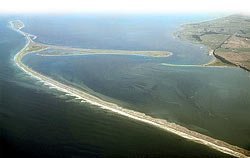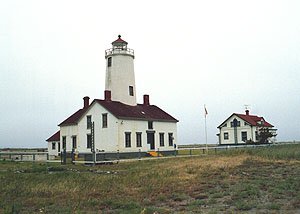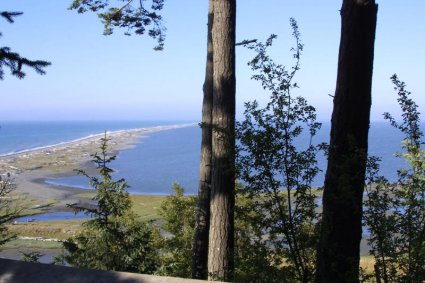
 |
|
| Graydog Home | Sequim | Glass | Photography | GDS | |
|
|
Dungeness History
The North Pacific Ocean is known for its violence and towering waves. On the broad Strait of Juan de Fuca the energy barely subsides, especially during frequent windy periods. It is not surprising that captains of vessels battered by the turbulent waters sought refuge behind a long sand spit that curves northeasterly from the mainland at a point where the shore turns southerly. Spanish explorer Manuel Quimper is the first known European to land near the mouth of the Dungeness River. He claimed the land for Spain on July 4,1790, leaving a wooden cross and a cairn of rocks. Captain George Vancouver was next to record a visit, dropping anchor in tranquil, shallow waters in May, 1792. In his log he rhapsodizes that the nearby land presented . . . a landscape almost as enchantingly beautiful as the most elegant finished pleasure-grounds in Europe. . . a beautiful variety of extensive lawn, covered with luxuriant grass and diversified with an abundance of flowers. While we stopped to contemplate these several beauties of nature in a prospect no less pleasing than unexpected, we gathered some gooseberries and roses. . ' He also commented on other wild fruits and shrubs-gooseberries, raspberries, currants, sweetbrier, roses. Vancouver named the location New Dungeness, for it reminded him of an English harbor called Dungeness. A substantial group of Indians, perhaps 1,000 people, lived well in cedar longhouses at Cline's Spit, slightly east of Dungeness Spit, near the site later called New Dungeness, fishing and hunting, fighting and playing as their ancestors did back into the mists of time. Early explorers indicated that their trading friendships were fragile, hostility erupting with little warning. Yet in 1850 a brig captained by Thomas Abernethy stopped to take on provisions and water at New Dungeness. Attracted by the pleasant land, Abernethy returned in spring,
1851, to stake a claim (other accounts put this date at 1852 or 1853). Fellow
sailors B.l. Madison, J.C. Brown, John Donnell, Jim Connelly and Elisha
McAlmond also filed claims at different locations nearby-McAlmond on the
bluffs, Madison at the mouth of the   The Sequim Gazette September 18,1991 Dungeness (England) residents bring gifts to namesake By George McCormick In 1792, Captain George Vancouver landed inside what is now Dungeness Bay, and called it "New Dungeness" because of its resemblance to old Dungeness in England. Old Dungeness is in Kent, and lies about 25 miles southwest of Dover on the southeastern coast of England projecting into the English Channel. It is possibly the best example in the world of a cuspate shingle foreland. The "ness, which means headland, was formed over 3,000 years from flint eroded from the chalk cliffs to the west, it has been rounded by thousands of years of wave action. The pebbles were transported by sea and deposited in a series of great
storms, forming numerous ridges. Each ridge traces a former shoreline and the
process of shingle movement, known as "long shore drift still continues. The two Dungenesses came together briefly last week when Ernie and Helene
Ford, of the Dungeness area of England, visited its new world namesake, bearing
gifts from the old country. The Fords, on a three week visit to the United States, rented an airplane in
Lincoln, Calif., near Sacramento, and flew north stopping at Sequim airport on
their way to Blame. From Blame they were driven to Vancouver, B.C. They arrived on a foggy afternoon last Thursday and visited Jim and Shirley
Hill in Dungeness. Friday, they were escorted by the Hills, and by Harriet U.
Fish, a local historian, on a visit to various landmarks and a walk on the
Dungeness Spit. Friday afternoon at the old Dungeness Schoolhouse, they presented a coat of arms from Lydd, England (the nearest town to Dungeness), some old photographs and other memorabilia to the people of the local Dungeness.
 Old Dungeness was originally called Dengeness back before the 1600's. The first of five lighthouses was built there in 1615, and consisted of a coal fire on top of a wooden platform. Because of poor upkeep, and the movement of Dungeness point out to seaward, the light was left too far inland, and a new tower, the second lighthouse, was built in 1635. Over the past 350 years the point continued to grow seaward, the
present lighthouse, built in 1961, is 540 yards further out than the second
tower. The third lighthouse was built in 1792, and 18 spermoil lamps replaced
the coal fires. An electric light was installed in 1862, only to be replaced by
a huge oil lamp. Lighthouse number four, completed in 1904, was 143 feet
high, 38 feet in diameter at ground level, and painted externally with black
and white stripes. "The light from the lighthouse shines into our home, Ford said, and we can
watch the ships go by. There's an estimated 700-1,000 ships a day that go
through the English Channel, and the ferries between England and France cross
those shipping lanes. It's remarkable that there haven't been a lot of
accidents. The first refuge was set aside at 1,180 acres in 1931. Today, there are 2,029
acres in the reserve which is visited annually by more than 180 species of
birds. Mammals common on the shingle include rabbits, hares, foxes, stoats,
field vole, wood mouse, shrews and hedgehogs. Two major differences between the Dungenesses, according to Ford, is that
Dungeness in England is the site of two nuclear power plants. "The first one is
25 years old, "he said. "The other was finished in 1988. Ford works at one plant while Helene Ford works at the other. "We commute
about seven miles from our home in New Romney to work, Ford said. The other
difference is a railroad that runs along the shore. The Romney, Hythe and Dymchurch Light Railway, billed as "The smallest public
light railway in the world. The Fords were put in touch with the Hills by Don Campbell, when he responded
to their letter to the Sequim-Dungeness Valley Chamber of Commerce. 
|
|
©2005 Graydog Services • webmaster: jim(at)graydog(dot)org |